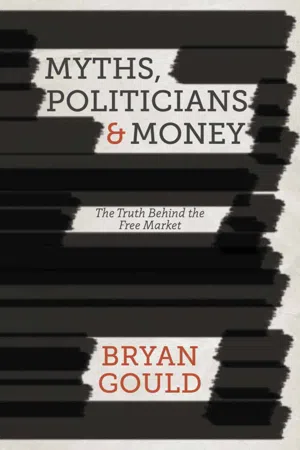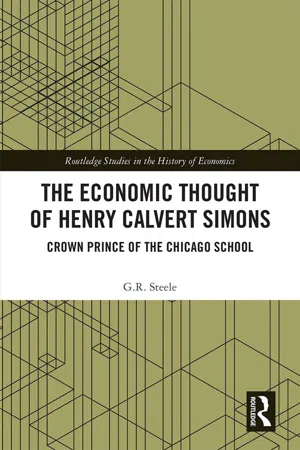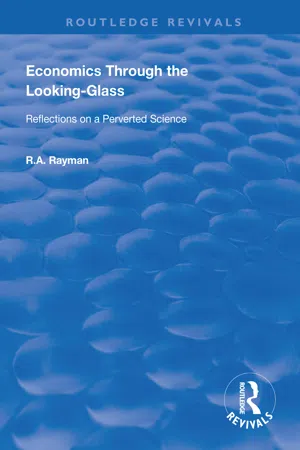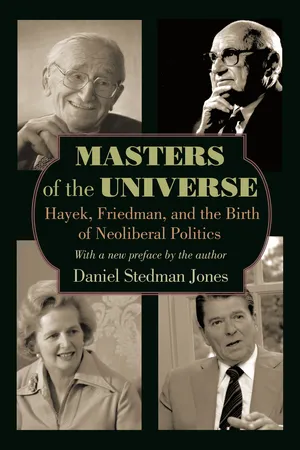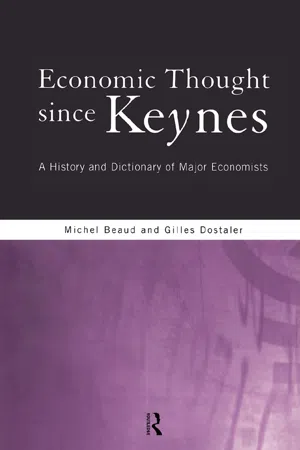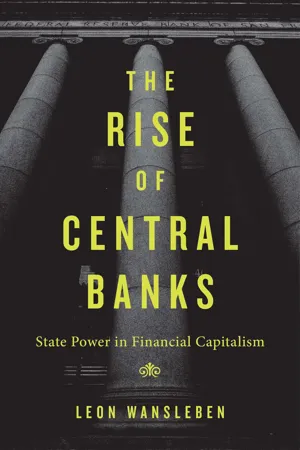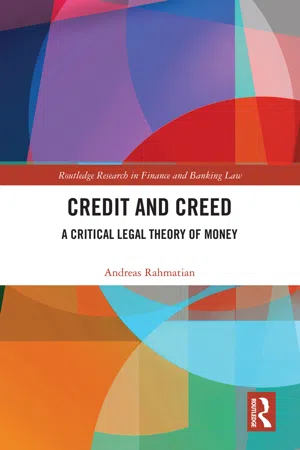Economics
Monetarism
Monetarism is an economic theory that emphasizes the importance of controlling the money supply to achieve economic stability and growth. It was popularized by economist Milton Friedman and advocates for central banks to focus on managing the quantity of money in circulation. Monetarists believe that changes in the money supply have a significant impact on economic activity and inflation.
Written by Perlego with AI-assistance
Related key terms
Related key terms
1 of 4
Related key terms
1 of 3
12 Key excerpts on "Monetarism"
- Grahame Thompson(Author)
- 2014(Publication Date)
- Routledge(Publisher)
CHAPTER 6Monetarism and economic ideology
Grahame Thompson AbstractThis paper looks at the economics of ‘Monetarism’. After a discussion of the conceptualization of money and the way it functions, the mechanisms by which ‘Monetarism’ analyses the relationship between the money supply and price formation are highlighted. It is argued that these are inadequate, largely because they are couched at an aggregative macro-level. A reformulation is suggested based upon the necessity to define the economic agents in the economy whose practices and processes provide the basis for the price formation and money-supply generation. The concept of a ‘money-supply’ is raised and the difficulties of defining and controlling this in a developed financial system are discussed. Finally a gesture is made towards the way in which an alternative financial mechanism might develop.1 IntroductionIn recent years there has been a significant growth of interest in ‘Monetarism’ both as an economic theory and as a strategy for economic policy. Such interest is by all accounts something of a world wide phenomenon, though it has tended to form a more focussed discussion in those advanced industrialized countries that are suffering particularly badly from the effects of economic recession. One such country is Britain. In May 1979 a Conservative government was elected here on a more or less explicit monetarist ‘ticket’.This paper looks at the economics of ‘Monetarism’.1 It takes the form of a running commentary on two recent booklets, published in Britain, that address themselves to ‘Monetarism’: Tim Congdon’s Monetarism: An Essay in Definition produced by the Centre for Policy Studies and Bryan Gould, etal. The Politics of Monetarism a Fabian Society Tract. In addition the paper looks at a recent document issued jointly by the Treasury and the Bank of England which is concerned with the issue of money supply control: Cmnd. 7858, Monetary Control published by HMSO (hereafter the Green Paper- eBook - ePub
Myths, Politicians and Money
The Truth Behind the Free Market
- B. Gould(Author)
- 2013(Publication Date)
- Palgrave Macmillan(Publisher)
The only business of government, it is said, is to maintain the value of assets, and particularly the currency, by controlling inflation, and that task – being essentially technical – is not really the business of politicians or the concern of democratic processes at all. This simple approach to economic policy is often called ‘Monetarism’ because of its emphasis on monetary policy. It is a doctrine that I have resisted since it was first adopted, in its modern guise, in the late 1970s. 1 This supposedly new approach to economic policy was enthusiastically adopted by those who favoured ‘free-market’ policies and the new opportunities provided by the emergence of the global economy because it was seen to be the correct economic corollary to the political prescriptions of Hayek and Nozick and entirely consistent with the minimalist economic role that was the proper function of the state. The enthusiasm for the monetarist approach to macroeconomic policy advocated by economists such as Milton Friedman was sometimes almost laughable. A classic example was when William Rees-Mogg – then editor of The Times and a recent convert to Monetarism – solemnly proclaimed in a leading article published on 13 July 1976 that a monetarist approach to the control of inflation removed all uncertainty from the exercise. He asserted that inflation was like water passing down a hosepipe; the rate of increase in the money supply at any given time would emerge at the other end of a two-year-long hosepipe as the rate of inflation. He purported to validate this assertion by producing figures showing that an average annual 9.4 per cent increase in the money supply in the nine-year period 1965–73 had – hey presto! – emerged as an average annual inflation rate at exactly 9.4 per cent for the nine years 1967–75, that is, two years later - eBook - ePub
- Brian Snowdon, Howard Vane(Authors)
- 1997(Publication Date)
- Routledge(Publisher)
Part IIThe monetarist counterrevolution
Passage contains an image
Introduction
‘Monetarism’, a term first introduced by Karl Brunner (1968), refers to a school of economic thought which initially evolved in the United States to attack the orthodox Keynesian analysis and associated policy-activism of the 1950s and 1960s. The historical development of the orthodox monetarist school can be traced in three main stages (see Snowdon et al. 1994). The first main stage, from the mid-1950s to the mid-1960s, involved an attempt, by Professor Milton Friedman and his associates, to re-establish the quantity theory of money approach to macroeconomic analysis. In this approach changes in the money supply are regarded as the predominant, though not the only, factor explaining changes in money income. Friedman’s (1956) seminal article on ‘The Quantity Theory of Money: A Restatement’ in which he asserted that the demand for money (and by implication velocity) is a stable function of a limited number of variables lies at the heart of the modern quantity theory approach. However, it was the breadth and depth of empirical evidence cited in Friedman and Schwartz’s (1963) book on A Monetary History of the United States, 1867–1960 which was particularly influential in reviving interest in the potency of money in generating cyclical fluctuations. Their analysis of the US historical record provided strong support for the view that independent movements of the stock of money played a significant role in causing macroeconomic instability. According to Lucas (1994) this book played ‘an important—perhaps even decisive—role in the 1960s’ debates over stabilization policy between Keynesians and monetarists’.The second main stage in the development of orthodox Monetarism involved the expectations-augmented Phillips curve analysis which was absorbed into monetarist analysis after the mid-to-late 1960s. Central to this phase is Friedman’s 1967 Presidential Address to the American Economic Association, subsequently published in 1968 in the American Economic Review as ‘The Role of Monetary Policy’. In this article (reprinted on pp. 164–79) Friedman denies the existence of a permanent/long-run trade-off between inflation and unemployment and introduces the natural rate of unemployment hypothesis. The essence of this hypothesis is a reaffirmation of the classical view that in the long run nominal magnitudes cannot determine real magnitudes such as employment and output. According to Friedman monetary policy cannot, other than for very limited periods, achieve some target unemployment rate and any attempt to maintain unemployment below the natural rate will produce accelerating inflation; a prediction subsequently borne out by the experience of many western economies during the 1970s (see Snowdon and Vane 1997). In the conduct of monetary policy he prescribes that the authorities pursue a ‘stable’ rate of monetary growth in line with the trend/long-run growth rate of the economy to ensure long-run price stability. Friedman argues that the natural rate of unemployment can be reduced only by appropriate supply-side microorientated policies which improve the operation of the labour market. In 1981 Robert Gordon described Friedman’s 1968 paper as probably the most influential article written in macroeconomics in the previous twenty years. More recently James Tobin (1995), one of Friedman’s most eloquent, effective and long-standing critics, has described the paper as ‘very likely the most influential article ever - eBook - ePub
The Economic Thought of Henry Calvert Simons
Crown Prince of the Chicago School
- G.R. Steele(Author)
- 2018(Publication Date)
- Routledge(Publisher)
From among Simons’s papers, there is an undated and ‘unidentified statement on government expenditure and depression’, 5 wherein Simons argues that the action necessary to raise prices is best taken in ‘the form of generous federal expenditures, financed without increase of taxes on commodities or transactions’. A passage in Personal Income Taxation (1938) reinforces that undated assessment: Once a deflation has gotten under way … Only great government deficits can check the hoarding of lawful money and the destruction of money substitutes … the proper checks in this direction also are to be found in the taxing, borrowing and spending activities of the national government. (Simons, 1938, p. 222) The tenet of (original) Monetarism is that inflation is caused by an excess supply of money, the corollary of which is an excess demand for goods and services. If individuals hold too much of one thing, they must hold too little of another. Fiscal Monetarism is a derivative of Monetarism. The conceptual change is both minimal and fundamental. The tenet of Fiscal Monetarism is that inflation is caused by an excess supply of sovereign debt. The recurring theme of Monetarism is that ‘inflation is always and everywhere a monetary phenomenon’; but with Fiscal Monetarism, that becomes ‘inflation is always and everywhere a sovereign debt phenomenon.’ In reiterating key features from Chapter 7, it is revealing and practically relevant to consider a national central bank and a national sovereign treasury as ‘two-in-one’ – i.e., for the interrelated decisions taken by a central bank and a treasury to be analysed as those from a single authority (referenced as the ‘sovereign’). From that perspective, sovereign debt consists of money and bonds. Respectively, these are: (i) short-term base money (banknotes and bank reserves, i.e., claims on the central bank); and (ii) longer-term debt (sovereign bonds, i.e., claims on the treasury) - eBook - ePub
- Krish Bhaskar, David F. Murray(Authors)
- 2015(Publication Date)
- Routledge(Publisher)
13 The New MonetarismDOI: 10.4324/9781315677064-14Introduction
This chapter is primarily concerned with tracing the reasons for the recent re-emergence of money as one of the major weapons in the central government’s policy armoury. The chapter begins by summarising the major factors which have influenced the prevailing view of the efficacy of monetary policy and leads naturally on to a brief discussion of the empirical evidence which, together with Friedman’s theoretical restatement of the quantity theory1 – dealt with in Chapter 11 – has played an important part in the revival of interest in monetary policy.The problem of the unpredictability of time lags which is thrown up by the empirical work is shown to be crucial in summarising the monetary view of the role of money and leads us to distinguish sharply between the long run and short run.While the monetarist revival owes a great theoretical and empirical debt to Friedman’s work many other notable economists such as Brunner and Meltzer have played important parts in the heated debate of the 1960s.2Historical background
In the 1920s the money supply was generally accepted as the major policy instrument and observers attributed the relative stability of this period to the successful operation of monetary policy. The same observers, however, attributed the great depression of 1929 and the mid-1930s with its high unemployment and falling prices to the ability of monetary policy to stop prices rising but its inability to stimulate the economy and hence employment during a depression. It appeared, therefore, that monetary policy was incapable of dealing with the problem of a depressed economy and this general view was held until the early 1960s when empirical work started to suggest that monetary policy had not failed; rather the depression was in fact a result of the extremely deflationary monetary policy which the authorities had operated at that time. We shall return to this subject in our discussion of the empirical evidence later in this chapter. - eBook - ePub
Economics Through the Looking-Glass
Reflections on a Perverted Science
- R.A. Rayman(Author)
- 2019(Publication Date)
- Routledge(Publisher)
Monetary expansion to finance a rise in real wages earned as the reward for an increase in productivity is therefore to be welcomed. An improvement in living standards of this type is a characteristic feature of the economic progress which impressed Adam Smith.A monetarist policy of keeping monetary expansion in line with real expansion would also have the effect of preventing the monetary system from being put out of order by government interference. It is therefore advertised as a policy of non-intervention designed to allow the economy to realise its fullest practicably attainable potential (at the “natural rate” of unemployment) with a reasonable promise of price stability.Control over the money supply is recommended not only for preventing inflation but also as a cure. “Monetary policy can hold any inflationary dangers in check by a slower rate of monetary growth than would otherwise be desirable” [p.14].The inflationary dangers caused by irresponsible monetary expansion to finance wage claims which are not justified by increased productivity have been demonstrated in Figures 11.2 and 11.3 .The monetarist answer is firm monetary discipline.Faced with inflationary pressure of the kind illustrated in Figure 11.4 (a) (which is a reproduction of Figure 11.3 (a)), the government must stand firm. If it refuses to finance inflationary wage claims by monetary expansion, the demand curve will remain atD2 D2 .Instead of following the path described in Figure 11.3 (b), the economy will remain atA. This halts the wage price spiral, but the volume of employment will remain depressed at2½ON2½, Unemployment will rise above its “natural rate” to an extent indicated by the distanceN2½ N2in Figure 11.4 (a).Figure 11.4 : The Inflationary Spiral — Monetarist Resistance“Unemployment is an inevitable side effect of an effective policy to damp down inflation ... — because of the time that it takes for the tapering off of total demand to be recognised by employers and employees for what it is, and for contractual arrangements to be readjusted to the new situation” [1974(b)]. - eBook - ePub
Rethinking Macroeconomics
A History of Economic Thought Perspective
- John F. McDonald(Author)
- 2021(Publication Date)
- Routledge(Publisher)
Conservative economists downplay the importance of monopolies, externalities, and information problems. For example, monopoly limits alternatives for consumers, so it is an inhibition of freedom. Monopoly most often results from government policy or collusive agreements, so the first things to do are to eliminate the offending policies and to enforce the anti-trust laws vigorously. Mainstream economists agree with this point; both schools of thought supported the deregulation of the airline, trucking, and electric power industries. For monopolies that occur naturally from technological factors, the choices are government regulation, government operation, or private monopoly. For Friedman (1962, p. 28), permitting private monopoly “may be the least of the evils.” And externality problems can be solved by private negotiations more often than one might think. Besides, the attempt by government to regulate externalities may make things worse. Mainstream economists largely do not follow the conservatives on this point; pollution and traffic congestion are two serious problems that cannot be solved by private negotiations. Both schools of thought include the proposition that information problems can be attacked by rules requiring transparency.Monetarism
The Monetarism of Milton Friedman and his colleagues is a coherent body of thought that produced a huge body of research that includes numerous doctoral dissertations written at the University of Chicago. Recall that the Quantity Theory of Money that can be stated as:MV = PY = GDP,- where
- M = the stock of money however measured;
- V = the velocity of circulation of money, i.e., the number of times the stock of money is used to purchase final goods and services in a year;
- P = the overall price level; and
- Y = the real level of output of final goods and services.
- P = MV/Y,
- M = PY/V, and
- V = PY/M.
The Quantity Theory of Money provides a convenient explanation for inflation, which is the continuing increases in prices. The basic idea is that if the supply of money keeps rising, so will prices. Money supply increases are directly linked to inflation, provided that real output and the velocity of money do not change (or change very little). The empirical evidence for the hypothesis linking money and inflation is voluminous. As Milton Friedman said often, “Inflation is always and everywhere a monetary phenomenon.”Consider the American Civil War. The Confederate side had very little ability to finance the war other than by printing money. Further, states, local governments, and private firms printed money too. By the end of the war in 1865, consumer prices had increased by 9,000 percent. Confederate money was worthless, and people were carrying on routine transactions by barter. Then there is Weimar Germany. Saddled with unrealistic reparation payments after World War I, the government printed money instead of imposing taxes or borrowing. The price of a gold Mark in terms of paper Marks at the end of various years were: 10 in 1920, 100 in 1922, and 1 trillion in 1923 (that is 1,000,000,000,000). A recent example is the nation of Zimbabwe. The government printed money to pay for wars against other African countries and to pay corrupt officials. The official exchange rate against the U.S. dollar was 1,000 to 1 on January 1, 2004, 107.5 to 1 on January 1, 2008, and 1023 - eBook - ePub
Masters of the Universe
Hayek, Friedman, and the Birth of Neoliberal Politics - Updated Edition
- Daniel Stedman Jones(Author)
- 2014(Publication Date)
- Princeton University Press(Publisher)
It was in the seemingly narrow and technical arena of economic strategy, then, that the transatlantic neoliberal ideological and political movement first entered the mainstream policy agendas of the Conservative and Republican Parties and, just as important, the policies of the Labour and Democratic Parties. Monetarism’s first political foray came in Britain, not through Friedman but with the machinations of then Conservative financial secretary to the treasury Enoch Powell in the late 1950s. In the United States, Friedman and other Chicago school economists threw down the gauntlet in the 1960s, and by the end of the decade, monetarist ideas were gaining traction among growing numbers of the political and technocratic elite, precipitated by the first signs of monetary crisis, inflation, and, in Britain, rising labor unrest. At the dawn of the 1970s, Friedman and his supporters seemed to offer a plausible set of remedies just as faith in Keynesian tools was about to collapse under the weight of years of stagflation.Pure theory did not mix easily with the temporal imperatives of politics and elections. As the former British chancellor of the exchequer Nigel Lawson put it, economic history was often “more useful than theory.”2 There was also much confusion about what Monetarism actually was, how to measure money, how to determine the aspects of Keynes that worked and those that did not, and, finally, whether Monetarism and “supply-side” reforms—tax cuts, labor market reform, and market-based antipoverty strategies, for example—were in conflict. In the end, both Keynesianism and Monetarism suffered from many of the same problems, primarily a lack of accurate economic information and measurement. But in the late 1960s and 1970s, Friedman’s Monetarism and its variants seemed to offer the clearest alternative to the perceived failures of economic management revealed by the disasters of the seventies. This was due in part to the force and skill with which the case was argued and promoted by transatlantic neoliberals in both Britain and the United States.Keynes and KeynesianismJohn Maynard Keynes towered over economic policy in the twentieth century. It is important, however, to differentiate between Keynes the man, his own ideas, and the ideas of his followers in the postwar period.3 Keynes died prematurely in 1946, exhausted by his efforts to negotiate a loan from the Americans. His intellectual legacy was defined by a flexible approach to both economic theory and practical politics. He famously stated that “in the long run we are all dead,” by which he meant that economic policy should serve people and their needs rather than the long-term requirements of economic theory. According to Keynes, “economists set themselves too easy, too useless a task if in tempestuous seasons they can only tell us that when the storm is long past the ocean is flat again.”4 This attitude lay at the heart of his debates with Hayek during the 1930s.5 Keynes thought that democracies could not tolerate—indeed, as the experience of the 1930s had demonstrated, might not survive—a repeat of the perils of large-scale unemployment. Consequently, he turned his wits to the development of a set of economic proposals to attack and prevent economic depression. The big question for supporters and critics ever since has been whether Keynes’s ideas worked outside the circumstances of the 1930s and 1940s. (Some, of course, never acknowledged that they worked even in this context.) Keynes himself, chameleon-like, constantly changed his mind—he famously responded to Hayek’s detailed critique of his Treatise on Money - eBook - ePub
Economic Thought Since Keynes
A History and Dictionary of Major Economists
- Michel Beaud, Gilles Dostaler(Authors)
- 2005(Publication Date)
- Routledge(Publisher)
But the political divergence is very clear. Modigliani thus described it, in his discourse, already quoted, entitled ‘The Monetarist Controversy or, Should We Forsake Stabilization Policies?’:In reality the distinguishing feature of the monetarist school and the real issues of disagreement with nonmonetarists is not Monetarism, but rather the role that should probably be assigned to stabilization policies. Nonmonetarists accept what I regard to be the fundamental practical message of The General Theory: that a private enterprise economy using an intangible money needs to be stabilized, can be stabilized, and therefore should be stabilized by appropriate monetary and fiscal policies. Monetarists by contrast take the view that there is no serious need to stabilize the economy; that even if there were a need, it could not be done, for stabilization policies would be more likely to increase than to decrease instability; and, at least some monetarists would, I believe, go so far as to hold that, even in the unlikely event that stabilization policies could on balance prove beneficial, the government should not be trusted with the necessary power. (Modigliani 1977, p. 1)In Modigliani's opinion, the monetarists’ attack against Keynesianism is not directed against the Keynesian theoretical structure as such, but revolves around the question of knowing whether this framework implies the need for stabilization policies. Concerning the necessity of state intervention, his position is very clear: ‘We must, therefore, categorically reject the monetarist appeal to turn back the clock forty years by discarding the basic message of The General Theory. We should instead concentrate our efforts in an endeavour to make stabilization policies more effective in the future than they have been in the past’ (ibid., p. 18).One of the principal creators of the neoclassical synthesis, John Hicks, has never sought to compromise with the monetarist approach. It is by using the IS-LM diagram that monetarists, neoclassical Keynesians and new macroeconomists were successfully able to compare their respective positions as regards the mechanisms at play in the economy. From one to the other, only the shape and position of the curves varied. Hicks, as we have already emphasized, preferred to keep his distance in relation to this scheme of analysis, of which he was the initiator.30 - eBook - ePub
- Geoffrey Ingham(Author)
- 2013(Publication Date)
- Polity(Publisher)
The practical consequences of the well-established, but untenable, distinction between money and credit slowly became more apparent, but not before the myriad forms of credit-money supply had given rise to new measures of the money supply. M 2 led to M 3 and so on to M 17. The policy became increasingly inoperable. Later, in the early 1990s, as credit-money continued to expand at annual rates of over 25 per cent per year, but inflation fell quite markedly, the very foundations of quantity theory came under question (Henwood 1997: 201–2; Guttmann 1994). Monetarism’s policy incoherence directly reflected the theoretical incoherence of the revamped orthodox theory of money, which, it must be remembered, was already anachronistic at the time of its refinement by Fisher in the early twentieth century. Monetarist theory was developed, with no significant modification of the assumptions regarding the natural economy. In the hands of the early classical economists, precious metal currency was seen to be an exogenously provided ‘public good’. Credit-money and bank clearance, which accounted for virtually all the significant transactions of the capitalist economy, were excluded from this category of money-proper. It is, therefore, not too surprising that this analytical framework proved to be totally inadequate for the understanding of the process whereby capitalism’s money is created and controlled. ‘Rational expectations’ and inflation With the failure of Monetarism, orthodox monetary policy has become ever more detached from orthodox monetary theory. The fundamental tenets and assumptions, such as the long-run neutrality of money, survive, but they do not directly inform the immediate concerns of practical policy making. 13 Attention is now almost exclusively focused on the means by which ‘inflation expectations’ might be stabilized (see Part II, chapter 7). ‘Rational expectations’ theory contends that rational economic agents will wish to avoid inflation - eBook - ePub
The Rise of Central Banks
State Power in Financial Capitalism
- Leon Wansleben(Author)
- 2023(Publication Date)
- Harvard University Press(Publisher)
51This cautiously framed finding supported the advocacy by senior Bank officials of an alternative strategy to credit ceilings, resulting in a common commitment to restrain the expansion of credit via targets for the broad monetary aggregate M3. Importantly, this agreement left open how such monetary restraint was to be achieved. The very choice of M3 as the relevant monetary aggregate meant that different policy tools could be used for that purpose. For M3 was a broad measure of banking-sector liabilities (customers’ checking and saving accounts) whose volume was directly influenced by government borrowing, as the banks’ major asset position. Hence, fiscal policy and debt management, as much as monetary policy or banking regulation, provided potential tools for taming M3 growth (Goodhart 1986: 80). The British officials thus translated Monetarism very differently from the Swiss, creating a monetary targeting framework that aligned with the high degree of centralization of its policymaking apparatus and the close interaction between public debt and monetary growth in the British banking system.52But as a result of this specific translation, the role of monetary policy remained underspecified and uncertain. Needham speaks of a “misalignment of understanding between the Bank, the Treasury and the Heath government” (2014b: 169). In the Bank and some parts of the Treasury, there prevailed the hope that M3 targets would encourage restraint in credit-financed government expenditure (via reductions in the fiscal deficit and / or by selling more government bonds to the nonbank public), accompanied by hikes in the Bank rate. But restrictive monetary policy or reduced borrowing remained out of the question. The Prime Minister and the Chancellor instead decided in the early 1970s that Britain needed another “dash for growth.” Cheap funding conditions remained essential for this policy, both for government and private business (ibid.: 70–71). Consequently, no attempt was made to enhance the status of monetary policy in order to hit the internally agreed target. - eBook - ePub
Credit and Creed
A Critical Legal Theory of Money
- Andreas Rahmatian(Author)
- 2019(Publication Date)
- Routledge(Publisher)
138136 ‘Monetarism’ usually denotes for economists the focus on the macroeconomic effects of money supply, see e.g. Mankiw (2013: 530).137 Chapter 1, sec. 2(a)(iv).138 Friedman, Quantity Theory , pt. 23 (1956: 19).The problem is that legal or economic concepts do not remain in the conceptual or modelling stage but enter social reality. Friedman mentions that it is difficult to ‘commodify’ or ‘monetise’ human labour force as ‘human capital’.139 However, modern human resource management and managerialism work hard to achieve exactly this goal. The numerical calculation of the substitution of non-human capital by human capital can be done much better with ‘zero-hours’ contracts.140 These have the additional advantage that they promote a complete atomisation of society and a destruction of any solidarity in the work force, and give no employment protection. Here, as well as in other precarious work relationships, the human being is reduced to its labour force that is rather accurately expressed in market prices. These, in turn, provide sufficiently clearly the desired terms of substitution of human capital for other forms of capital. In that way the modern non-slave society and slavery start converging, of course not in technical law but in the changed social function of the legal concept behind the possibly unchanged formal legal rule (positive law).141 This aspect of alienation is an essential part of the conception of all-encompassing monetisation which the modern money system entails.142
Index pages curate the most relevant extracts from our library of academic textbooks. They’ve been created using an in-house natural language model (NLM), each adding context and meaning to key research topics.
Explore more topic indexes
Explore more topic indexes
1 of 6
Explore more topic indexes
1 of 4

